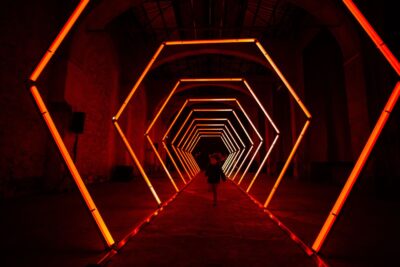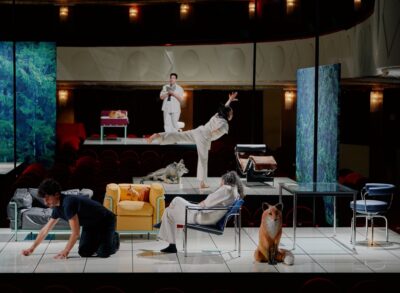Performing sold-out 3D concerts around the world, boasting over two and a half million Facebook friends and singing an incredible repertoire of more than 100,000 user-released songs, Hatsune Miku is possibly Japan’s greatest pop star. Now artist Keiichiro Shibuya features Hatsune Miku in his creation The End, the first Vocaloid opera – an opera without an orchestra or human vocalist, constructed from multi-screen 3D images and electronic sound. The only performers who appear are Hatsune Miku, an animal character (virtual as well), and – the only living human – Keiichiro Shibuya, a musician constantly pushing the frontiers of music. Miku begins her journey by asking herself: ‘will I die?’ For, in spite of the special Louis Vuitton designed outfits, she is not a real human being, but originates from voice synthesizer software by Japanese company Crypton Future Media. Travelling through a virtual world, accompanied by Shibuya’s score of minimal techno and EDM, modern and contemporary classical music and sound art, Miku goes in search of the paradox of her own existence.
BACKGROUND INFORMATION
With over two and a half million Facebook friends and an incredible repertoire of more than 100,000 songs, Hatsune Miku is Japan’s biggest pop star. Her concerts are huge events, with fans lighting up sold-out stadiums as they wave about their ‘magic’ wands. With her heart-shaped face, dominated by large eyes and framed by long turquoise hair down to her hips, you might think Hatsune Miku looks quite unreal. And you might be right, because Hatsune Miku has no beating heart. She is a virtual singer, and her voice is produced by singing voice synthesizer software developed by Crypton Future Media INC for YAHAMA’s Vocaloid synthesizer. Still, that hasn’t prevented Miku from taking the world by storm and now starring in the very first Vocaloid opera in history: The End.
Hatsune Miku’s voice is produced using samples of a voice artist. By adding lyrics and melody into the synthesising programme, users can generate a vocal performance. To set her apart from the competition, i.e. other voices, Crypton decided to give Miku not only a voice but also an image. Created by manga artist Kei Garō, who has portrayed her as a 16-year old girl with big eyes and turquoise pigtails, this turned out to be a brilliant move. Hatsune Miku, whose name means ‘first sound of the future’, came to this world in 2007, the third in a series of ‘Vocal Characters’ developed by Crypton. After the release, Hatsune evolved into a phenomenon of a highly participatory internet culture with thousands of people creating and sharing Miku-related contents around the globe. At present, with more than 1,000,000 derivative artworks and 100,000 user-released songs, Hatsune Miku is not only the icon of this ever expanding creative community, but she is also successful in performing sold-out 3D concerts worldwide, appearing in TV commercials, and being featured in various artists’ works.
Miku’s whispered, breathy way of singing and her artificial tone colour might lack warmth and expression compared to a real singer, but in spite of that she rose to become the biggest pop phenomenon in Japan almost instantly. Although, people have also claimed it’s actually because of her artificiality that she is so popular, linking her success with other examples of Japan’s penchant for the unreal. Whatever the reasons may be, the fact remains that Hatsune Miku is hugely successful. Supported by four very human virtuoso musicians, she brings the house down in concert after concert.
Hatsune Miku’s runaway success gave Keiichiro Shibuya, composer and frontman of the electronica collective Atak, the idea to write an opera for the Vocaloid star: The End. The award-winning playwright Toshiki Okada (who featured at the Holland Festival in 2011, directing his three-part play Hot Pepper, Air Conditioner, and the Farewell Speech), was hired to write the libretto; illustrator YKBX (pen name of Masaki Yokobe) created the animations.
Aiming to transform opera with the goal of a radically new space/time creation that is neither traditional nor avant-garde, The End is the first Vocaloid opera project ever, an opera without an orchestra or a single human vocalist, constructed from multi-screen 3D images and computer-controlled electronic sound. The only performers who appear on stage are Hatsune Miku, a cuddly rabbit-like creature called Animal, and Keiichiro Shibuya.
The set and the three characters are three-dimensional projections, the electronic music is controlled by Shibuya, who sits on stage behind his keyboard. The action is set in a virtual world.
Playing on the notions of mortality and being human, The End explores the paradox between what’s real and what’s unreal. The floating set combines manga-like forms with angular, geometrical shapes. Dominated by abstract computer animations, the show also features a giant lilac-coloured heart, suspended from fluorescent barrels. A massive coffin-like chest, suggesting death and burial, is the only permanent element to the set.
Composer Keiichiro Shibuya, a musician known for pushing the frontiers of music across pop, electronic sounds, experimental music and sound installations, has delivered a mix of J-pop ( the most popular music genre in Japan, rooted in traditional Japanese music fused with Western pop music), techno, trance and progressive club electro with some influences of minimal music. The music, tonal with some unusual modulations in places, is, apart from Miku’s singing, dominated by heavy synths. Especially for this opera, Miku is dressed by Louis Vuitton’s artistic director Marc Jacobs and his team. The virtual costumes are all original designs, tailor-made for Hatsune Miku’s body-type and personality. The digitised images reveal both a fully contemporary and completely new Miku, as part of this unprecedented special collaboration.
Unlike traditional opera, The End lacks a detailed plot and is more focused on a flow of moods and metaphysical speculation. Asking herself the question whether she will die like us humans, Hatsune Miku embarks on a quest searching for the secret to her identity. When she is visited by the spectre of a woman with a mysterious odour, she learns of a a secret which gets her thinking. The secret remains shrouded in mystery, but the morning that the woman came, Miku realises later, was the morning the ‘reason for her existence’ was born.
Miku is also visited by a sweet-looking, cuddly rabbit-like creature called Animal. He seems to be guarding her, anxious for her not to leave. As Miku does not need to breathe, she can talk faster than humanly possible (as exemplified in her final aria), but if nobody feeds her any lines, she is speechless. This is the very paradox which constitutes her tragedy. In a sense, she exists, she talks and sings, but the question is: ‘Who or what is she’?
BIOGRAPHIES
Composer and interpreter of electronic and acoustic music Keiichiro Shibuya (1973) studied at the National University of Fine Arts and Music in Tokyo. In 2002, he formed ATAK, a music label and artists’ collective combining music, fashion and design. Shibuya writes music for film and TV, as well as creating various sound installations, including a 3D installation called Filmachine, which was featured at a number of festivals. Following this project, Shibuya released ATAK010, a CD with three-dimensional sound, which can only be listened to with headphones. In 2009, he embarked on an international concert tour, called ATAK NIGHT4, together with Ryoji Ikeda, Yasunao Tone and others. That same year his first album for solo piano was released, ATAK015 for maria. In 2012 Shibuya organised a homage to John Cage, on the occasion of the centenary of his birth, as well as launching a new single, Sacrifice, with Rina Ohta. Shibuya has participated in many projects using huge sound installations. In collaboration with the writer and philosopher Azuma Hiroki he launched Initiation Shibuya Keiichiro + Azuma Hiroki feat. Hatsune Miku. The End, which he wrote in 2012, is his first opera and the world’s first opera with completely synthesised vocals using the Vocaloid computer programme.
Toshiki Okada (1973) is a Japanese writer and director. In 1997 Okada formed the theatrical company chelfitsch – the name is a child-like play on the English word ‘selfish’ and a fitting denominator for the company’s commentary on contemporary Japanese society. Okada’s plays are characterised by their strong expressiveness, humour and rich, physical visual language. In his plays, Okada takes the way in which young Japanese people speak and think to its extreme – using hyperrealistic colloquial language in fragmented semi-monologues along with strange body movements which often seem divorced from the actors’ words and thoughts – up to the point where all communication breaks down. Okada is seen as the director who gave Japan’s post-bubble lost generation a voice. Okada’s work has received numerous honours and awards. Five Days in March won the prestigious Kishida drama award in 2005. Air-Conditioner/Cooler was a finalist at the 2005 Toyota Choreography Awards. For his two part novel The end of the special time we were allowed, Okada received the 2008 Kenzaburō Ōe Prize. For his oeuvre, he received the Yokohama Cultural Award/Yokohama Award for Art and Cultural Encouragement. As well as directing his own plays, he has also directed Samuel Beckett’s Cascando, Kōbō Abe’s Friends and Dea Loher’s Tätowierung. Having toured Europe for the first time in 2008, Okada made his debut at the Holland Festival in 2011 with Hot Pepper, Air Conditioner, and the Farewell Speech. In 2012 he created his first English language production, Zero Cost House.
Hatsune Miku is a virtual Japanese pop idol enjoying unprecedented popularity in Japan. Which is all the more remarkable as Miku is not a singer of flesh and blood, but a computer programme, singing synthesiser software paired with the drawn image of a singer who comes to life as an animated 3D projection at her concerts. Miku’s voice is generated using samples of the Japanese voice actress Saki Fujita, which the makers of Crypton Future media subsequently programmed into Yahama’s Vocaloid 2 synthesizer programme. Users of the application can create their own songs – with the voice of Miku – by adding their own lyrics and melodies. The name Hatsune Miku means ‘first sound of the future’.
Miku’s image was created by the Japanese illustrator KEI. Inspired by Crypton’s description of Miku as ‘an android diva from the near future’, he created a Manga-like character with long turquoise pigtails and a blue and grey outfit – the colour scheme was based on Yahama’s synthesisers. When Hatusune Miku for Vocaloid 2 hit the market in Japan in 2007, it was an instant success. Subsequently the package for Miku was extended with software to give Miku’s voice various different moods. The fan community developed the animation software to make her dance. Thanks to video upload sites such as Niconico, Hatsune’s repertoire has grown exponentially, now counting more than 100,000 songs, many with an accompanying video.
Miku’s first live concert was in 2009 at the Animelo Summer Live Festival. Her concerts in Japan are hugely popular events, with crowds of fans in sold out stadiums waving their magic light wands to her music. Miku’s first foreign concert – Mikunopolis – was in 2011 in Los Angeles. In late 2013 her first pop opera, The End, premiered in Paris.





